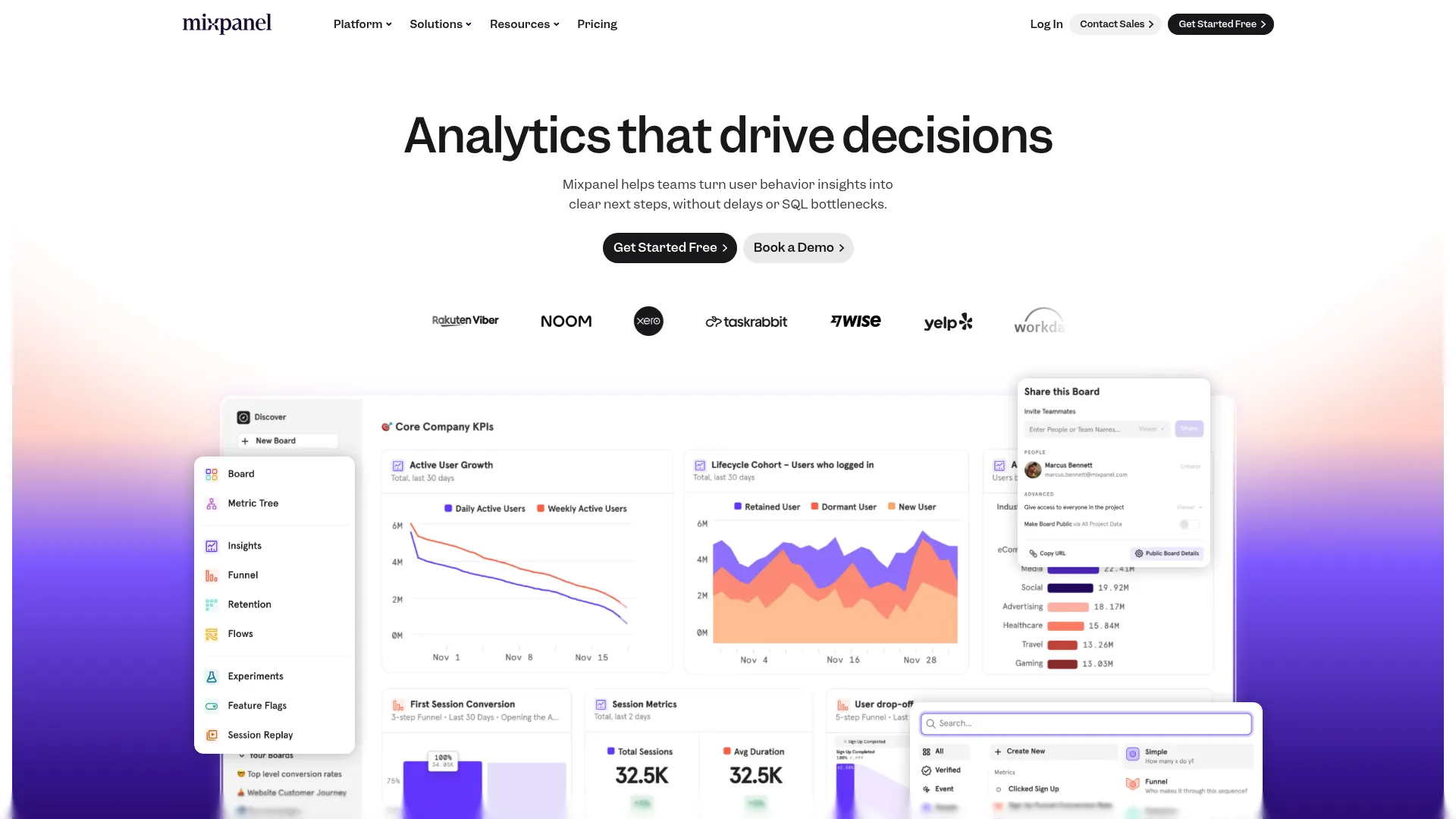
Mixpanel Review: The Complete Breakdown You Need Before Investing
I’ve been testing Mixpanel for the past few months, and honestly? It’s been a rollercoaster. This popular product analytics platform has some seriously impressive capabilities, but it also comes with frustrations that I wish someone had warned me about upfront. If you’re trying to decide whether Mixpanel is worth your time and money, I’m going to walk you through everything – the good, the bad, and the surprisingly expensive.
Table of Contents
-
TL;DR: Key Takeaways
-
What is Mixpanel?
-
Alternatives to Mixpanel
-
Frequently Asked Questions
-
Final Thoughts
TL;DR: Key Takeaways
-
Mixpanel is incredible at tracking every tiny user action but you’ll need your developer friend to set it up properly
-
That “free” tier can turn into a $500+ monthly bill faster than you’d expect at $0.26 per 1,000 events
-
The segmentation features are genuinely amazing – probably the best I’ve seen anywhere
-
Non-technical teams will struggle – this isn’t a plug-and-play solution
-
The charts and reports are powerful but sometimes so overwhelming you’ll want to throw your laptop out the window
-
Perfect for product teams with developer support who need to understand exactly how users behave
Criteria Table
|
Criteria |
Score |
Description |
|---|---|---|
|
Technical Implementation & Setup |
3/5 |
You’re gonna need your developer friend. Event naming conventions will make your head spin. |
|
Event Tracking Capabilities |
5/5 |
Tracks literally everything users do. Want to know how long someone hovers over a button? Mixpanel’s got you. |
|
Reporting & Visualization |
4/5 |
Powerful stuff, but some reports (looking at you, Flows) are confusing as hell. Charts could use better labeling. |
|
User Segmentation & Analysis |
5/5 |
This is where Mixpanel absolutely shines. Slice and dice your users any way you want. |
|
Integration Ecosystem |
4/5 |
Plays nice with most tools you’re probably already using. Data warehouse connections work well. |
|
Pricing & Scalability |
3/5 |
Free tier is generous until it isn’t. Costs can spiral quickly if you’re not careful about event tracking. |
|
Support & Community |
3/5 |
Hit or miss. Some users love it, others complain about debugging nightmares and a pretty useless mobile app. |
What is Mixpanel?
What Mixpanel is Best Known For
Here’s the thing about Mixpanel – it completely changed how I think about analytics. Instead of just counting how many people visited your website (yawn), it tracks every single thing users do as individual events. Button clicks, feature activations, purchases, even how long someone spends reading your pricing page – Mixpanel sees it all.
I’ve seen Mixpanel completely change how product teams make decisions. The flexible funnel analysis is what really sets it apart from those rigid, template-based tools that make you feel like you’re wearing a straitjacket. You can build funnels around any series of user actions and filter by pretty much anything. It’s like having X-ray vision for your conversion bottlenecks.
The real-time data thing? That’s where Mixpanel gets exciting. During a product launch last month, I watched conversion metrics update live as we made tweaks to the onboarding flow. No waiting around for reports to process – you see results as they happen, which is honestly pretty addictive.

Features
Let me walk you through the features that actually matter in real-world use:
Signal App is like having a data scientist constantly analyzing your Mixpanel data to surface patterns you’d never notice on your own. It automatically identifies events that correlate with your key business metrics, which sounds boring but is actually incredibly useful when you’re trying to figure out what drives user retention.
Impact Tracking tells you exactly how new features affect engagement and retention. When you roll out updates, you’ll know immediately if they’re helping or hurting – no more guessing games or waiting weeks to see trends.
The built-in A/B testing integrates seamlessly with your analytics data. You can run experiments and see how they impact your key metrics all in one place, which saves you from juggling multiple tools.
JQL is Mixpanel’s custom query language. If you’ve got someone on your team who knows SQL, they’ll love this – it’s basically Mixpanel’s way of letting you dig into your data however you want, beyond what the standard interface offers.
Group Analytics is crucial if you’re selling to businesses rather than individual consumers. Instead of just tracking individual users, you can analyze entire companies or accounts, which gives you a completely different perspective on how your product is being used.
Custom Dashboards let your entire team stay aligned on key metrics. You can add annotations and share insights, which is super helpful when you need to explain why certain numbers spiked or dropped.
Pros
The Detail is Genuinely Impressive
The level of granularity you get with Mixpanel is unmatched. Every user interaction becomes a data point you can analyze, segment, and act on. Want to know what percentage of users who viewed your pricing page actually started a trial? Easy. Want to see how that breaks down by traffic source, device type, and time of day? Also easy.
Build Exactly What You Need
Unlike tools that lock you into predefined reports that never quite fit your business, Mixpanel lets you build exactly what you need. I’ve created custom funnels for everything from onboarding flows to feature adoption, and the flexibility means you can adapt the platform to your specific business model.
Non-Technical People Can Actually Use It
The no-code query builder is genuinely user-friendly. I’ve watched marketers and product managers create complex analyses without writing a single line of code. The interface takes some getting used to, but once you learn it, you can get insights independently without bugging your developer.
No Surprise Bills
You know exactly what you’re paying for based on event volume. There aren’t hidden fees or mysterious charges that show up on your credit card statement. The pricing scales predictably with your usage, which I appreciate even if it can get expensive.
They’re Not Standing Still
Mixpanel recently added heatmaps and session replays, which shows they’re actively working to keep up with competitors. You’re not stuck with a platform that’s going to become obsolete in two years.
Cons
Setup Will Test Your Patience
Look, I’m going to be straight with you about this because I wish someone had told me upfront. Getting Mixpanel properly configured requires developer involvement, and it’s not a quick afternoon project. I helped a startup implement it last month, and their developer literally spent three days just figuring out the event naming conventions. It was painful to watch.
The Learning Curve is Real
Maximizing Mixpanel’s potential takes serious time and effort. Your team needs to invest significant energy to become proficient with all the features. I made the mistake of not training my team properly at first, and we ended up using maybe 20% of what we were paying for.
The Pricing Thing Stings
That free 1 million events sounds generous until you realize that a single user session can easily trigger 20-30 events. Do the math – you’ll hit that limit faster than you think. I’ve seen companies go from loving their free tier to getting hit with a $500+ monthly bill seemingly overnight.
Some Reports Are Confusing as Hell
The Flows feature, in particular, can be overwhelming and hard to interpret. Sometimes the wealth of data makes it difficult to extract actionable insights quickly. I’ve spent way too much time staring at flow charts trying to figure out what they’re actually telling me.
The Mobile App is Honestly Pretty Useless
I tried checking our metrics during a product launch while I was traveling, and half the features just weren’t there. Super frustrating when you need quick insights on the go. The mobile app feels like an afterthought.
Criteria Evaluation
Technical Implementation & Setup: 3/5
You’re gonna need your developer friend for this one. The naming conventions and parameters needed for optimal results can get complex, especially if you’re not technically inclined. I’ve seen too many implementations where manual event tracking led to messy, incomplete data because it wasn’t handled carefully from the start.
Event Tracking Capabilities: 5/5
This is where Mixpanel absolutely dominates. You can track literally everything – when someone hovers over a button, scrolls to a specific section, or even abandons a form halfway through. The real-time analysis and ability to compare events across different time periods make this feature genuinely exceptional.
Reporting & Visualization: 4/5
The funnel, cohort, retention, and flow reports are genuinely powerful and provide comprehensive insights. But here’s the thing – some of these reports can be overwhelming and confusing, particularly the Flows feature. The charts also lack some basic user-friendly features like proper Y-axis labeling and have limited color customization options.
User Segmentation & Analysis: 5/5
This is where Mixpanel truly shines. The advanced user segmentation based on demographics, behaviors, and interactions is top-notch. The cohort analysis and retention tracking are sophisticated, and the B2B-friendly group analytics give you insights that most other platforms can’t match.
Integration Ecosystem: 4/5
Mixpanel plays nice with most of the tools you’re probably already using. The integrations with leading software platforms work well, and the direct data warehouse connectivity is solid. It integrates nicely with CDPs and offers good native integration options, though you might occasionally wish for even more choices.
Pricing & Scalability: 3/5
The free plan’s 1 million event limit is genuinely generous for small businesses, but costs can escalate quickly at $0.26 per 1,000 events beyond that threshold. Enterprise features get costly fast, and add-ons can significantly drive up your total investment before you know it.
Support & Community: 3/5
This one’s hit or miss. User feedback reveals complaints about debugging difficulties and those mobile app limitations I mentioned. Reviews on precision and event tracking accuracy are mixed, which suggests there’s room for improvement in customer support.
Community Reviews and Expert Recommendations
The user reviews I’ve read consistently highlight Mixpanel’s powerful analytics capabilities while mentioning setup complexity and cost concerns. Technical teams love the granular tracking, but non-technical users struggle with implementation. The expert consensus seems to be that you need developer resources and careful cost planning.
G2 reviews consistently praise Mixpanel’s analytical depth while warning about implementation challenges. Users love the detailed insights but frequently mention that steep learning curve and need for technical expertise during setup that I experienced firsthand.
Capterra feedback emphasizes the platform’s powerful segmentation capabilities, though several reviews note that costs can spiral quickly for high-volume applications. Multiple users recommend careful planning around event tracking to avoid unnecessary expenses – something I learned the hard way.
TrustRadius reviews highlight the real-time analytics as a major advantage, particularly for product teams running frequent experiments. However, multiple reviews mention frustration with some of the more complex reporting features being difficult to navigate, which matches my experience completely.
Industry experts consistently recommend Mixpanel for product-focused teams with technical resources, but suggest alternatives for marketing-focused organizations or those without developer support. The consensus is that Mixpanel delivers exceptional value when properly implemented but requires significant investment in setup and training.
Pricing
Here’s where things get interesting (and potentially expensive). Mixpanel offers a genuinely useful free tier with 1 million events, 5 saved reports, and 10K session replays. The Growth plan starts free but then charges approximately $0.26 per 1,000 events after you hit that threshold. Enterprise pricing is custom and designed for organizations processing serious event volumes.
The Starter plan is completely free and includes up to 1 million events, 5 saved reports, and 10K session replays. This is genuinely useful for small businesses or if you’re just getting started with product analytics and want to test the waters.
Growth pricing starts at $0 but kicks in at roughly $0.26 per 1,000 events once you exceed the free threshold. This usage-based model means your costs scale directly with your product’s success, which can be both exciting and terrifying depending on how you look at it.
Enterprise pricing is custom and designed for organizations with high event volumes or specific compliance needs. If you’re processing millions of events monthly, you’ll need to contact their sales team for pricing that makes sense at your scale.
Where to Find Mixpanel
You can explore Mixpanel directly at mixpanel.com where they offer a free trial to test the platform’s capabilities. Their documentation and learning resources are extensive and actually helpful for understanding the platform before you commit.
For enterprise inquiries, contact their sales team through the website. They’re generally responsive to questions about custom pricing and implementation support for larger organizations.
Alternatives to Mixpanel
Google Analytics 4 (GA4)
GA4 is the obvious free alternative, especially if you’re primarily focused on web traffic and marketing attribution. It’s widely adopted and offers solid acquisition metrics that many businesses need for basic tracking.
But let me be honest with you – the learning curve is genuinely horrible, and the product analytics capabilities are severely limited compared to Mixpanel. I’ve watched grown marketers nearly cry trying to set up simple conversion tracking in GA4. Choose this if you mainly need traffic tracking and can tolerate significant frustration during setup and daily use.
You can get started with GA4 at analytics.google.com for free, though expect to invest considerable time learning the interface and probably some therapy sessions.
Crazy Egg
Crazy Egg is perfect if you want analytics without the technical complexity that makes Mixpanel challenging. The built-in heatmaps and session replays provide visual insights that are immediately actionable, and the setup process is refreshingly simple.
Think of it as analytics training wheels – you’ll get useful insights without needing a computer science degree to interpret them. However, you’ll sacrifice the granular tracking an
Think of it as analytics training wheels – you’ll get useful insights without needing a computer science degree to interpret them. However, you’ll sacrifice the granular tracking and advanced features that make Mixpanel so powerful for detailed product analysis.
Explore Crazy Egg’s offerings at crazyegg.com with various plans starting at reasonable rates for small to medium businesses.
Userpilot
Userpilot is designed specifically for SaaS companies and combines analytics with user onboarding tools. The auto-capture events and no-code setup eliminate many of the technical barriers that make Mixpanel frustrating for non-technical teams.
The retroactive analytics feature is incredibly valuable – you can analyze historical data even for events you didn’t initially track. This is a lifesaver for SaaS businesses that need to understand user behavior patterns over time but didn’t have proper tracking set up from day one.
The entry price point is higher at $299/month, but you get both analytics and user experience tools in one platform. Check out their SaaS-focused approach at userpilot.com.
Amplitude
Amplitude is built specifically for product teams and offers advanced behavioral analytics that genuinely rival Mixpanel’s capabilities. The product analytics focus and advanced segmentation make it a strong alternative, and many users find the interface more intuitive than Mixpanel’s.
The visualization capabilities are robust, and I’ve heard fewer complaints about confusing reports compared to Mixpanel. However, implementation can still be complex, and pricing escalates quickly with usage – so you’re not necessarily escaping Mixpanel’s main drawbacks.
Amplitude offers a free tier to get started, with enterprise pricing that varies based on your needs. Explore their product-focused approach at amplitude.com.
Frequently Asked Questions
Is Mixpanel worth the cost for small businesses?
If you’re running a small business, Mixpanel’s free tier can provide genuine value with that 1 million events monthly limit. But here’s what you need to honestly assess: Do you have the technical resources for proper implementation? And do you actually need granular product analytics, or are you just trying to track basic website traffic?
If you’re primarily tracking website visits and basic conversions, simpler tools like Google Analytics or Crazy Egg will probably serve you better and save you a lot of headaches. Mixpanel shines when you need detailed user behavior analysis and have the technical team to set it up correctly. If you’re a solo founder trying to bootstrap everything yourself, honestly? Skip Mixpanel. You’ve got bigger fish to fry than learning complex analytics.
How difficult is Mixpanel to implement without a developer?
I’m going to be straight with you – implementing Mixpanel without developer support is challenging and often leads to incomplete or messy data. While the platform offers some no-code features, proper event tracking setup requires technical knowledge to ensure you’re collecting accurate data and getting meaningful insights.
The reality is that most successful Mixpanel implementations involve at least some developer involvement during the initial setup phase. You might be able to manage basic tracking on your own, but you’ll likely miss out on the advanced features that make Mixpanel truly valuable. Plan on at least a week if you want to do it right, and that’s if everything goes smoothly (spoiler alert: it probably won’t).
Final Thoughts
After months of testing and analysis, here’s my honest take: Mixpanel is an exceptional tool for product teams with technical resources and a genuine need for granular behavioral analytics. The platform’s event-based tracking approach provides unmatched insight into user behavior, and the advanced segmentation capabilities are truly industry-leading.
But here’s the thing – Mixpanel isn’t for everyone, and I wish more reviews were honest about this upfront. The technical complexity, steep learning curve, and escalating costs make it a poor fit for non-technical teams or businesses primarily focused on basic web analytics. If you’re looking for simple traffic tracking or don’t have developer support, you’ll likely find better value elsewhere and save yourself a lot of frustration.
The sweet spot for Mixpanel is product-focused organizations that need to understand detailed user journeys and have the technical expertise to implement it properly. If that describes your situation, the investment in setup and training will pay dividends in the insights you’ll gain. I tested this during Black Friday weekend, and being able to see real-time conversion data as our campaigns went live was honestly pretty amazing.
Before committing, take advantage of their free tier to test whether your team can effectively use the platform. The 1 million event limit gives you plenty of room to evaluate whether Mixpanel’s capabilities justify the complexity and eventual costs. My advice? Start with the free tier, get your hands dirty, and see if your team actually uses it before committing to paid plans.
Look, Mixpanel isn’t perfect. It’s complex, it can get expensive, and you’ll probably curse at it during setup. But if you stick with it and have the right team, the insights you’ll get are genuinely game-changing for product decisions. Just make sure you know what you’re getting into before you dive in.





